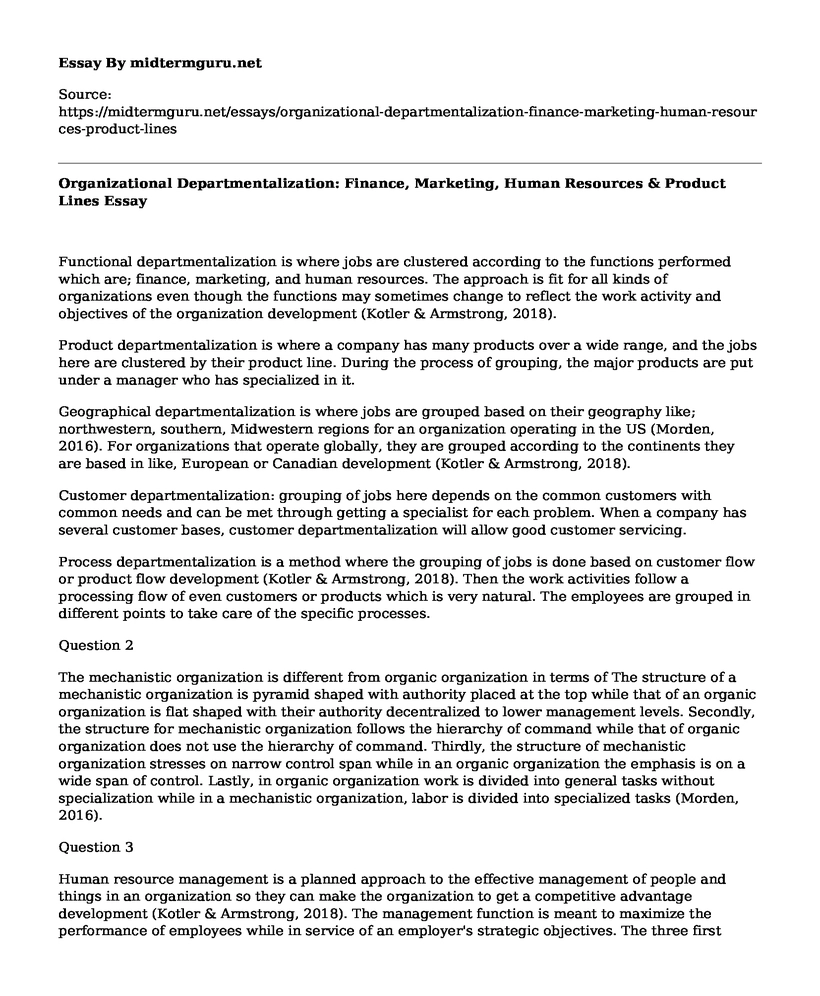Functional departmentalization is where jobs are clustered according to the functions performed which are; finance, marketing, and human resources. The approach is fit for all kinds of organizations even though the functions may sometimes change to reflect the work activity and objectives of the organization development (Kotler & Armstrong, 2018).
Product departmentalization is where a company has many products over a wide range, and the jobs here are clustered by their product line. During the process of grouping, the major products are put under a manager who has specialized in it.
Geographical departmentalization is where jobs are grouped based on their geography like; northwestern, southern, Midwestern regions for an organization operating in the US (Morden, 2016). For organizations that operate globally, they are grouped according to the continents they are based in like, European or Canadian development (Kotler & Armstrong, 2018).
Customer departmentalization: grouping of jobs here depends on the common customers with common needs and can be met through getting a specialist for each problem. When a company has several customer bases, customer departmentalization will allow good customer servicing.
Process departmentalization is a method where the grouping of jobs is done based on customer flow or product flow development (Kotler & Armstrong, 2018). Then the work activities follow a processing flow of even customers or products which is very natural. The employees are grouped in different points to take care of the specific processes.
Question 2
The mechanistic organization is different from organic organization in terms of The structure of a mechanistic organization is pyramid shaped with authority placed at the top while that of an organic organization is flat shaped with their authority decentralized to lower management levels. Secondly, the structure for mechanistic organization follows the hierarchy of command while that of organic organization does not use the hierarchy of command. Thirdly, the structure of mechanistic organization stresses on narrow control span while in an organic organization the emphasis is on a wide span of control. Lastly, in organic organization work is divided into general tasks without specialization while in a mechanistic organization, labor is divided into specialized tasks (Morden, 2016).
Question 3
Human resource management is a planned approach to the effective management of people and things in an organization so they can make the organization to get a competitive advantage development (Kotler & Armstrong, 2018). The management function is meant to maximize the performance of employees while in service of an employer's strategic objectives. The three first processes of human resource management are recruitment, training and employee management or development (Kotler & Armstrong, 2018).
The recruitment process is the very first and is not easy for HR and may sometimes be the most challenging among all the functions they have. A lot of time, attention and mobilization is needed in the process. The management will have to attract the candidates to apply for the position they want in the company.
Training is the second process that comes after the HR manager has recruited some employees (Morden, 2016). The process involves refresher training ensuring the employees are updated on the developments in their areas of expertise. In training, there will be a set of training modules, training recruits and monitoring their work.
Employee development is the third, and the process subsumes training, involving employee's growth in their career through mentorship to prepare them for future leadership in the company.
Part 3
Question 1
Netflix's competitive strategy began as a cost leader since they began as the cheapest option, but later they raised their prices to match their competitors. Currently, they are trying to make themselves different by adding blockbuster level content and by partnering with television providers to offer their services.
Question 2: Porter's five forces in the case study for Netflix are:
The threat of new entrant is moderate. Netflix being a recognized sector in the movie industry, there is a likelihood of competition intensifying in the future.
High bargaining power of the buyers. Netflix implements a business model that gives consumers high bargaining power.
The threat of substitute services or products which moderate.
The bargaining power of suppliers is very high.
The conflict is existing among the competitors although it is moderate. That is seen with the increasing entrants' numbers to the digital on the demand market segment; thus high rivalry is expected among the competitors in the segment market.
References
Kotler, P., & Armstrong, G. (2018). Principles of marketing. Upper Saddle River: Pearson.
Morden, T. (2016). Principles of strategic management. Routledge.
Cite this page
Organizational Departmentalization: Finance, Marketing, Human Resources & Product Lines. (2023, Jan 11). Retrieved from https://midtermguru.com/essays/organizational-departmentalization-finance-marketing-human-resources-product-lines
If you are the original author of this essay and no longer wish to have it published on the midtermguru.com website, please click below to request its removal:
- Questions on Total Addressable Market - Paper Example
- Nike Company Analysis - Paper Example
- The Impact of Bank Saving Interest Rate in Banking the Population of Democratic Republic of the Congo: Research Proposal
- Essay Sample on Soft Drinks
- Corporate Copy Centre: The Innovative Solution for Copying & Printing Needs - Essay Sample
- Ab InBev: A Rich History of Mergers & Acquisitions - Essay Sample
- Buc-ee's: Highway Oasis for Texas and Beyond - Essay Sample







